
Feature Article
Organic Food and Food Safety
With increasing popularity of organic food, many local retailers now sell different types of organic food, ranging from fresh vegetables, rice, cereal grains, meat to processed foods. Personal values of consumers influence their attitude towards organic food and thus their choices. For example, some choose organic food out of concerns for the environment and animal welfare, while some are of the view that consuming organic food can minimise the intake of synthetic chemicals such as pesticide residues and additives.
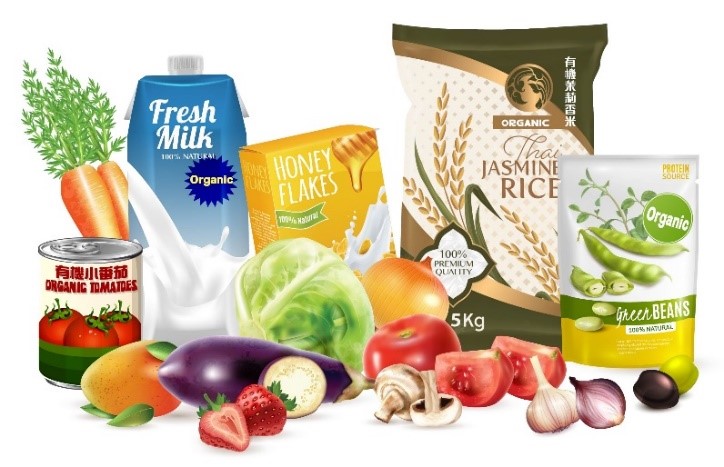
Many types of organic food are available in Hong Kong.
The Food and Agriculture Organization (FAO) and the World Health Organization of the United Nations (UN) define organic agriculture as a holistic production management system that promotes and enhances agroecosystem health, including biodiversity, biological cycles and soil biological activity. It emphasises the use of management practices in preference to the use of off-farm inputs, taking into account the local situation. This is accomplished by using, where possible, agronomic (e.g. crop rotations), biological (e.g. composting and biological pest control) and mechanical (e.g. tilling) methods, as opposed to using synthetic materials, to fulfil any specific function within the system.
To ensure that the requirements of the production management system are closely followed, inspectors appointed by certification bodies will visit farms and production sites for checks and audits. Food sold as “organic” usually carries an organic label of the certification body on its packaging for easy identification by consumers. Checking the organic label on the packaging of a product, be it locally produced or imported, helps to ensure that the food you purchase is organic.
Organic Foods: Are they Safer?
The FAO also pointed out that while organic farming may bring about benefits in respect of the environment, animal welfare, consumer preferences and income and food security for small farmers, it is not a guarantee of food safety. Organic farming means following certain production management standards throughout the production process, but it is not a food safety system. Chemical and microbiological contamination cannot be ruled out as pesticides extracted from plants are allowed to be used in organic food, and microbiological contamination from the environment and humans, etc. is possible. The main differences between organic food and conventional food lie in the production, processing and handling methods. The food safety standard that organic food has to meet is the same for any other food produced by conventional methods. In general, both organic and conventional farming can produce safe food as long as proper agricultural practices are adopted.
Mascot ON in Lesson
- Let's Beat COVID-19 Together
To minimise the risk of COVID-19 transmission in food premises, operators are advised to maintain high standards of hygiene and cleanliness. The Centre for Food Safety (CFS) recommends the following measures:
Physical Distancing
- Food premises can take the following measures to maintain physical distancing among employees, between employees and customers and among customers:
- offer takeaway options to customers;
- avoid table sharing;
- modify seating arrangements to reduce direct face-to-face encounters;
- display posters or make announcement in the premises, or add markings at queuing or waiting areas to remind customers of physical distancing;
- add partitions to service counters to reduce direct face-to-face encounters between customers and employees;
- encourage the use of contactless payments (e.g. credit cards, mobile apps);
- arrange staggered breaks, working and meal hours for staff, etc.
Environmental Hygiene
- Operators should step up cleansing and regular disinfection in the food premises including kitchens, food rooms, scullery rooms, toilets (including water taps and toilet handles) and the seating area. Carry out disinfection by applying 1:99 diluted household bleach (i.e. dilution by mixing one part of bleach with 99 parts of water) regularly and when necessary.
- 1:49 diluted household bleach (i.e. dilution by mixing one part of bleach with 49 parts of water) should be used for cleaning places contaminated with respiratory secretions, vomitus or excreta.
Personal Hygiene
- Staff members should check their body temperature regularly. Those suffering or suspected to be suffering from an infectious disease or with symptoms of illness should be suspended from engaging in any food handling work. Wear a surgical mask if having respiratory symptoms, and seek medical advice promptly.
- Cover mouth and nose with tissue paper when coughing or sneezing.
- Practise good personal hygiene (e.g. wash hands before and after handling food, after carrying out clean-up activities, after handling food waste or refuse, and after visiting the toilet).
Food Hygiene
- Adopt “5 Keys to Food Safety” to ensure proper food handling practices.
- Provide serving chopsticks and spoons when necessary.
- Avoid displaying unwrapped ready-to-eat food (e.g. bakery products).
- Avoid organising food-tasting events.
- If disposable gloves are worn when handling ready-to-eat food, staff should be aware that gloves wearing is not a substitute for handwashing and the gloves should be used properly.
- How to Serve “Rice with Two Sides” Safely?
Offering Hong Kong-style dishes at affordable prices, “rice with two sides” are getting more and more popular. Customers may choose two dishes from over a dozen of options, which come with a generous amount of rice. When displaying such precooked dishes, food businesses should keep the food safe from contamination and at the proper temperature.
Characteristics of “Rice with Two Sides”
“Rice with two sides”, which serves precooked dishes, is readily available at restaurants, fast-food outlets, campus or staff canteens, supermarkets and food stands. Coming in wide-ranging varieties, these Hong Kong-style savoury dishes are kept and displayed in containers for diners to select. To cater for operational needs, food business operators who provide “rice with two sides” tend to prepare the dishes in large quantities ahead of time for later reheating and display at the food counter. These practices involve two key risk factors for food poisoning: preparing cooked food too far in advance and keeping food at an improper hot-holding temperature.
Keep Hot Food Hot
Keeping food at the temperature danger zone between 4°C and 60°C encourages germs to grow rapidly. If not served immediately after cooking, the food must be kept at a safe temperature to protect customers’ health. Hot food must be kept at above 60°C.
In the catering industry, a bain marie, either wet or electronic, is often used to maintain the temperature of prepared food. Some operators may put food in a bain marie at a temperature lower than 60°C (say 45°C) such that the food does not dry out quickly. Such practice of keeping food at the temperature danger zone allows harmful bacteria to proliferate. Therefore, operators should constantly monitor the food temperature and ensure that the food is kept at a temperature above 60°C. Display time should be minimised and customers should be reminded to consume the food as soon as possible after purchase. To make it easier for food to reach the desired temperature, hot-holding containers can be preheated before use. It is also not advisable to replenish the food by mixing newly cooked food with food that has already been displayed for a period of time.
- Insects and Insect Fragments in Cereals and Grains
Cereals and grains are agricultural products that are susceptible to infestation by pests such as rice weevils (Sitophilus oryzae). Foreign substances like insects may be found in grains (e.g. rice, corn, wheat, oats and barley) and their products (e.g. noodles and pasta). Infestation can happen before harvesting, during storage or on the production line. During food processing, some insects may be ground into fine fragments not visible to the naked eye.
Insects like rice weevils are harmless to human beings , animals, furniture and clothes. They do not bite or sting, but they damage the grains which they infest.
In general, insects cannot survive in grains with a low moisture content. Temperature control can be used when handling infested items. Rice weevils, for example, can be killed by heating the infested item to 60°C for an hour or freezing it at 0°C for a week. With that said, manufacturers should always follow good manufacturing practices, such as shortening the time between storage and processing of grain products, to reduce the chance of infestation. Consumers should avoid buying grain products with non-intact packaging and signs of infestation. After purchase, store grain products in airtight, sturdy containers and in a cool, dry place. Discard the grains if they are too damaged to be fit for consumption.
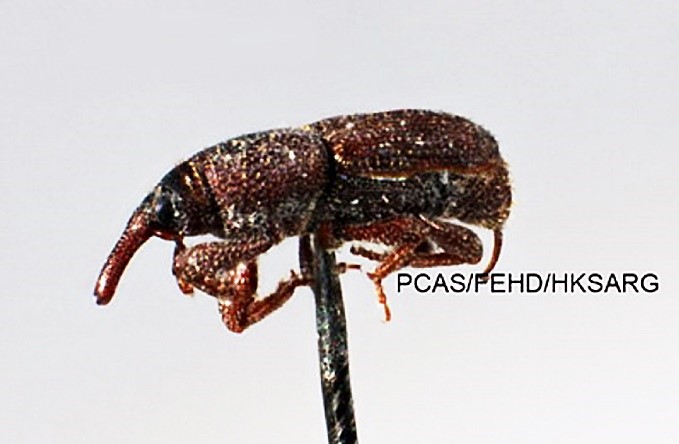
Rice weevil (Sitophilus oryzae) (By courtesy of the Pest Control Advisory Section, the Food and Environmental Hygiene Department)
Spot Check
Maintain Food Safety of Oysters to be Eaten in Raw State
To safeguard food safety and protect public health, the CFS and the Environmental Hygiene Branch of the FEHD have enhanced inspections recently to licensed food premises across the territory to ensure that oysters to be eaten in a raw state (raw oysters) are stored at the proper temperature.
The FEHD launched a series of operations across the territory from 14 to 20 April 2022 to step up inspections. In addition to giving health advice to operators and staff of food premises, food safety pamphlets were distributed to introduce the proper way of storing raw oysters: all raw oysters ready for immediate consumption shall be kept in a compartment of the refrigerator separated from other food items at a temperature between 0°C and 4°C.
Wet storage refers to the practice of storing live oysters temporarily by submerging them under water or heavy spraying. Under the Code of Practice for Fish and Fishery Products, the Codex Alimentarius Commission specifies that live bivalve molluscs must not be re-immersed in or sprayed with water after they have been packaged and have left the distribution centre. The temperature of a saltwater tank is usually not low enough to suppress bacterial growth, while mixing of raw oysters from different batches in the same water tank facilitates cross-contamination. Traders should store raw oysters intended for direct consumption at a controlled, uninterrupted cold chain and minimise the storage time to ensure food safety.
Oysters feed by filtering a large volume of seawater and absorbing suspended food particles therein, so microorganisms will accumulate in them if they are grown in or harvested from waters contaminated with bacteria (e.g. Vibrio parahaemolyticus and Vibrio vulnificus) and viruses (e.g. norovirus and Hepatitis A virus). Consuming oysters not cooked thoroughly may lead to risks of direct intake of these microorganisms. Susceptible groups, such as pregnant women, young children, the elderly and people with weakened immune systems or liver diseases, should avoid eating raw oysters.
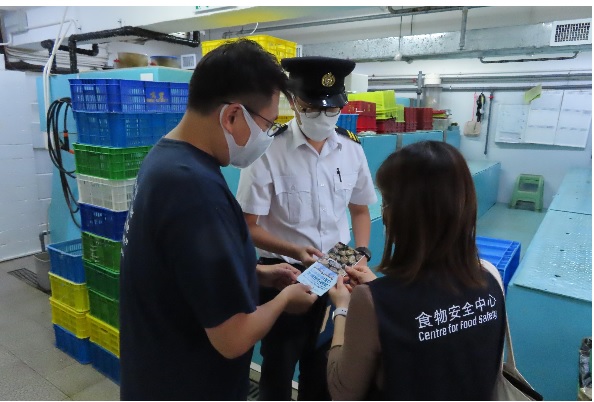
Safe Kitchen/Trade Talks/Food Safety Guidelines
Safe Kitchen
Introduction to “Safe Kitchen” Scheme
To facilitate trade members in adopting the Five Keys to Food Safety and good hygienic practices to enhance food safety in daily operation, the CFS has integrated the existing channels of risk communication to launch a new platform, namely “Safe Kitchen”, to communicate with the trade. The platform serves to provide food safety information of greater practical importance to meet the operational needs of catering outlets.
The “Safe Kitchen” platform disseminates up-to-date food safety information (including food safety guidelines and relevant legislative amendments) to the trade through a host of channels including WhatsApp, emails and dedicated websites. In response to food poisoning outbreaks in restaurants, the platform will also issue food alerts to remind the trade of the points to note in preventing future occurrences so that the risk of food poisoning can be minimised.
New dedicated websites and risk information exchange platforms will be rolled out under the “Safe Kitchen” Scheme. In addition, training materials tailor-made for the trade and workshops for kitchen staff will be provided to enhance food safety and hygiene awareness among them. Members of the trade are welcome to scan the QR code to download the registration form for the “Safe Kitchen” Scheme in order to receive the latest food safety information in a timely manner.

Trade Talks
Talk on Manufacture and Sale of Frozen Confections
Ice-cream, frozen yogurt and soft ice-cream are always popular in the scorching summer. However, if not handled properly (e.g. the storage temperature not low enough (≤-18oC) or the refrigerator door not properly closed), they will become prone to bacterial growth in the hot weather.
To ensure that frozen confections for sale are safe for consumption and enhance the awareness among the trade, the CFS organised the “Food Safety - Manufacture and Sale of Frozen Confections” trade talk on 30 May 2022. Apart from offering food safety advice on manufacture of frozen confections, the talk also provided information on possible pathogenic contamination during the production and sale of frozen confections and assurance of food safety under a sound food management system.
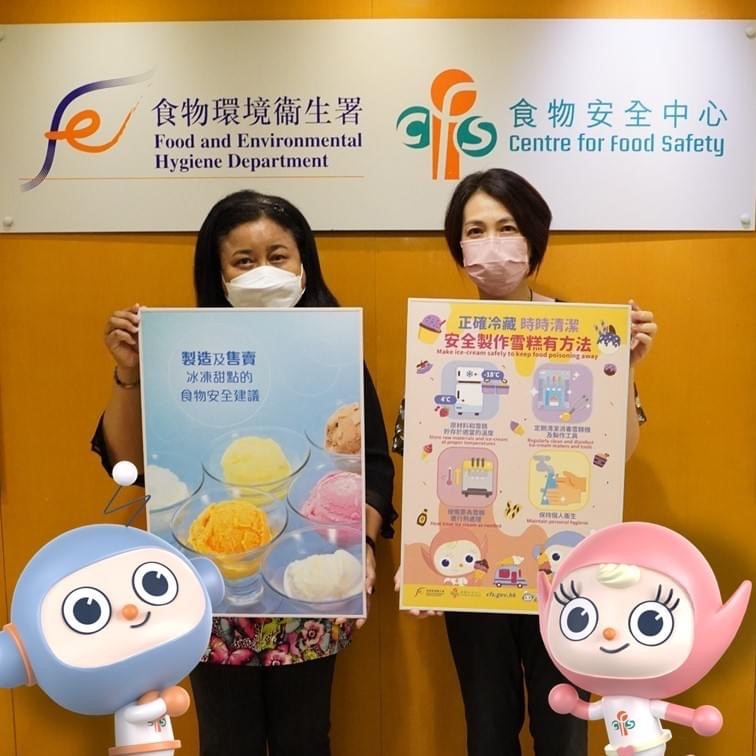
You may also refer to the “Food Safety Advice for Manufacture and Sale of Frozen Confections”, with details available at the following website:
https://www.cfs.gov.hk/english/multimedia/multimedia_pub/files/Frozen_Confections_e.pdf
Food Safety Guidelines
Food Safety Guidelines for Food Recovery
To make better use of food resources, some organisations operate food recovery projects, i.e. collecting and redistributing wholesome surplus food, to help people in need and at the same time minimise food waste. Food safety principles should apply to foods donated for charity, irrespective of their types and sources.
Safeguarding Food Safety in Food Recovery
Regardless of the modes of operation, food recovery projects are reliant on wholesome food donated in good faith. Food donation is similar to food purchase in the sense that the food should come from reliable sources, such as licensed food premises. Food from illegal or questionable sources should not be accepted.
Receiving / Picking up Food
- Pack the food in clean, covered containers and mark the receiving date as the food may not be distributed on the same day when it is collected.
- Store the food in appropriate places. For example, store chilled food in the refrigerator at 4℃ or below.
- Do not accept food that has been stored at inappropriate temperatures, such as ready-to-eat food kept at room temperature.
- Use insulated containers (e.g. coolers) and ice packs, if necessary, to maintain food temperature during transportation.
- Transport vehicles should not be used for purposes other than delivering food.
- Clean the transport vehicles on a regular basis.
Food Inspection
The following food should be discarded immediately:
Prepackaged food
- Food that is mouldy, odd-smelling, discoloured, unusually fragmented or loose, or showing signs of insect or rodent infestation;
- Food that is in packages with holes or tears, or with broken or tampered seals;
- Food in cans that are swollen, moderately to severely dented, rusty (except minor rust that can be wiped off), leaking, mouldy or with improperly formed/defective seam;
- Food in glass or plastic containers with bulging, loosened or crooked lids, showing leakage (stained label), or with cracks or flaws;
- Food that has passed its “use by” date; and
- Food that is not properly labelled with its name, ingredients and expiry date.
Fresh produce and meat
- Fresh produce that is mouldy, slimy, dried out, wrinkly, foul-smelling, or with excessive bruises/scars/soft spots;
- Sprouted potatoes;
- Refrozen food; and
- Raw meat with a rotten smell or discolouration, or with a large amount of purge/liquid in the package.
Ready-to-eat food
- Ready-to-eat food that is mouldy, stale or odd-smelling.
Bakery products
- Distribute the items before the expiry dates (if provided).
- If there are no expiry dates, only those without fresh cream and/or stuffing (such as sandwich and rolls) should be distributed.
- Food with fresh cream and/or stuffing (such as BBQ pork buns, tuna buns and sausage buns) to be stored overnight before distribution must be refrigerated.
News on CFS
1. Opening of Sea Routes as a Contingency Measure for Import of Fresh Food
The Mainland is the main source of fresh food in Hong Kong. Having regard to the import of food from the Mainland via the land route being affected by the COVID-19 pandemic in February 2022, the CFS fully supported the opening of sea routes to import fresh food. Five temporary food inspection checkpoints were set up swiftly at New Yau Ma Tei Public Cargo Working Area, Kwai Chung Customhouse, Cheung Sha Wan Wholesale Food Market, and the Hong Kong International Terminals Limited and Modern Terminals Limited in Kwai Tsing Container Terminals. A task force was also established to inspect import documents on-site and collect samples for testing under the risk-based principle.
Since 19 February 2022, vegetables, fruits, eggs, meat and poultry have been shipped to Hong Kong from Guangzhou Panyu Lianhuashan Port, Shenzhen Yantian Port, Shenzhen Dachan Bay, Shekou Container Terminal, Nansha New Port and Qingdao by sea to maintain the daily market supply of such essential fresh produce.
To facilitate smooth and swift release of food consignments, importers are advised to submit the arrival report and relevant import documents to the CFS for every consignment two days before the arrival. Apart from adopting conventional paper mode application, importers can submit the documents in a faster way online by uploading them to the Food Trader Portal. The trade may refer to the relevant leaflet or call the 24-hour enquiry hotline at 2708 9591 for details of the arrangements.
Apart from the development of water transport, the CFS also gave active support to expedite the transportation of food by railway and implemented various measures to improve land transport arrangements.


Staff members of the CFS are conducting food inspections at one of the temporary food inspection checkpoints.
2. Trade Consultation Forum
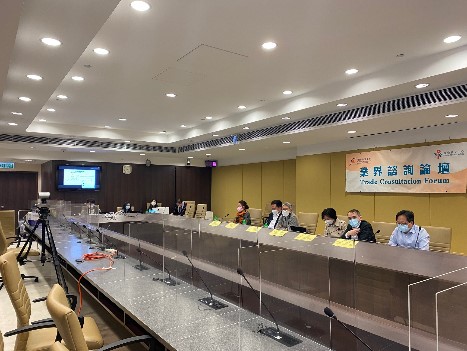

The 75th meeting of the Trade Consultation Forum (TCF) was organised on 28 October 2021. The agenda items included “Food Labelling and Nutrition Labelling of Prepackaged Food”, “‘Salt / Sugar’ Label Scheme for Prepackaged Food Products”, “Import Control of Milk and Milk Beverage”, “Import Control of Hairy Crabs”, and “US Marine Mammal Protection Act Import Provisions Rule”.
The 76th meeting of the TCF was held on 11 March 2022. The discussion topics included “Nitrite/nitrate Added in Food and Labelling”, “Open Up Transport of Vegetables and Fruits, Chilled Meat, Poultry and Eggs via Sea Route”, “Safety and Labelling of Genetically Modified Food” and “Food Traders’ Registration”.
You may browse the webpage of the TCF for details:
https://www.cfs.gov.hk/english/committee/committee_tcf.html

3. Food Safety Day 2022
The Food Safety Day, an annual signature publicity event organised by the CFS to echo the UN’s World Food Safety Day, will continue to be held online this year. Since there have been major local food poisoning outbreaks suspectedly caused by improper hand washing, the theme for Food Safety Day 2022 is “Clean Hands Well to Eat Well”.
In June 2022, the CFS reminded the public through social and traditional media of how and when to do proper hand washing. Food Safety Day 2022 offers a wide variety of activities, it is certainly not to be missed!

4. Talks on Seasonal Foods 2022
Various kinds of seasonal foods are put on the market in different seasons. If these speciality foods are not handled properly, it will pose food safety hazards and easily lead to food poisoning. The CFS will organise a series of food safety talks from May to December 2022 themed on rice dumplings, frozen confections, mooncakes, poon choi, safe provision of buffets and Lunar New Year food to enhance safety awareness with seasonal foods among the trade and suggest ways for trade members to assure food safety under a sound food management system. Please visit the CFS website for details of the talks.
Ask Our Mascots
Nutrition Labels – Address the Needs of the Whole Family
MUI: When buying food, what should we consider besides getting more bang for the buck? Health, of course! I am going to give you tips on how to use nutrition labels to make healthier choices.
Both nutrition labels and nutrition claims are covered in the Nutrition Labelling Scheme in Hong Kong. Nutrition labels provide nutrient values of packaged food so that consumers can:
✅ compare nutritional contents among different foods for a healthier choice (be a chooser, not a beggar);
✅ estimate the nutrient intake and its contribution to the overall diet based on the amount of food consumed (no more guesswork); and
✅ make food choices and adjustments to meet their health and dietary needs (help formulate personal meal plans).
The regulation on nutrition label covers a wide variety of food for people in different stages of life from infants and young children![]() to adults
to adults![]()
![]()
![]()
![]() . It includes not only some common prepackaged food (e.g. drinks, biscuits and nuts), but also infant formula, follow-up formula (e.g. milk powder) and prepackaged food for infants and young children (e.g. fruit puree and rice cereal) to address the nutritional needs of the whole family.
. It includes not only some common prepackaged food (e.g. drinks, biscuits and nuts), but also infant formula, follow-up formula (e.g. milk powder) and prepackaged food for infants and young children (e.g. fruit puree and rice cereal) to address the nutritional needs of the whole family.
MUI: Do you want to know how to utilise these useful nutrition labels and what nutrition claims are? Follow closely on our upcoming tips. You may also click on the following links to review the content![]() .
.
Resource Materials on Nutrition Labelling
https://www.cfs.gov.hk/english/programme/programme_nifl/programme_nifl_public_Resources.html
Nutrition Labelling of Prepackaged Food for Infants and Young Children
https://www.cfs.gov.hk/english/food_leg/food_leg_Formula_Products_for_Infants.html#sem
Knowledge Improvement Quiz
- What minimum core temperature should be reached for food to be “thoroughly cooked”?
- 65°C
- 75°C
- 85°C
- 90°C
- 100°C
- Which of the following is not a correct way to thaw frozen food?
- Defrosting by microwave oven
- Defrosting under running water
- Defrosting in the sink
- Defrosting by refrigerator at 4°C
- Which of the following seasonings can kill the bacteria in undercooked foods?
- Salt
- Vinegar
- Wasabi
- None of the above
Answers:
1. b 2. c 3. d
Diary of Mascot ON
Food Safety Guru Challenge
![]()
![]()
![]() Surprise Test
Surprise Test ![]()
![]()
![]() Do you want to become a food safety guru like #ON and #MUI
Do you want to become a food safety guru like #ON and #MUI![]() Here comes the chance! Let’s see if you remember by heart the food safety information shared by #CFSTeam. Show us how much you know about our mascots
Here comes the chance! Let’s see if you remember by heart the food safety information shared by #CFSTeam. Show us how much you know about our mascots![]() If you are one of the smart ones
If you are one of the smart ones![]() who get a perfect score, we may pay you a surprise visit to see how you put food safety into practice at home, and may even wash the dishes for you
who get a perfect score, we may pay you a surprise visit to see how you put food safety into practice at home, and may even wash the dishes for you![]()
![]()
![]() !
!
Click the following link to challenge yourself:
https://bit.ly/3iDK6dv
Act now! Share this with your friends and family and join the ranks of food safety gurus together!
